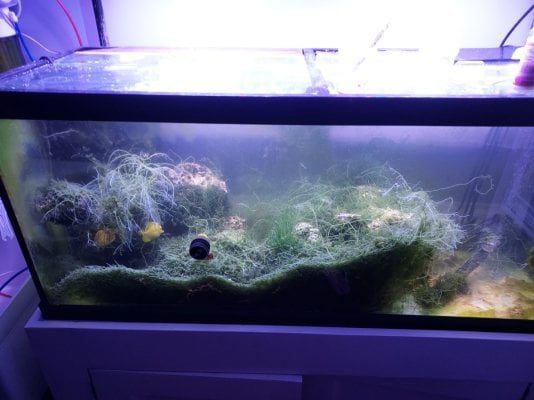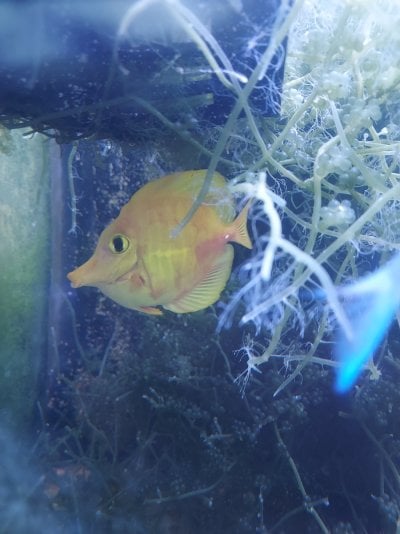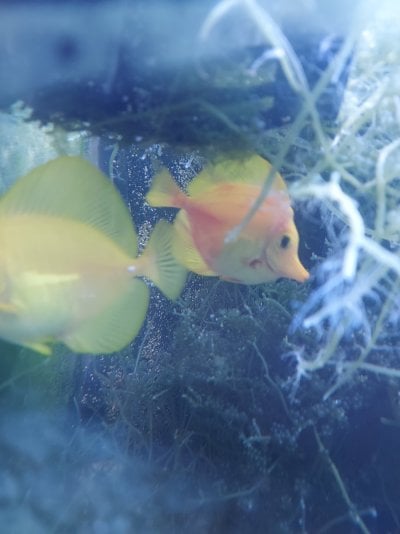#fishmedic
I thought I was dealing with a bacterial infection and while it still looks like one to me, but I'm coming out of the 3-round kanaplex treatment and not seeing any improvement so seeking a second opinion.
The facts:
* Two biota yellow tangs I've had since April 19th, so, a month and a half. They've have been eating like pigs and have fattened up nicely; one of them has yellowed up, the other has not yellowed as much.
* As mentioned these are biota fish so I am fairly confident that anything affecting them is from my system and not something they came with.
* They are in a 75 gallon holding tank for grow out until they are big enough to not be murdered by the adult tangs in my tank.
* Diet has been mostly mastic and nori, both of which they have been observed eating as recently as today, with mysis/brine depending on which one I grab that day, and reef frenzy (but some of the chunks are too big for them; I do not think they eat much of this.) Along with grazing in the tank.
* Tank mates are 1 blind chromis and a fairy wrasse.
* I have seen some jousting but doesn't seem like either fish is keeping the other from eating.
* About 10 days ago the paler of the two developed red patches. This worsened very quickly until Friday, when I started kanaplex.
* Kanaplex Friday, Sunday, Tuesday; last dose Tuesday morning.
* They have also received metroplex bound into mastic with focus.
* The paler tang does not seem to have improved (Though perhaps it stopped getting worse?)
* Today the other tang showed the very early signs of small pink spots.
* Looking closely at the red patches on the paler tang, there are very visible blood vessels. Up close it looks almost like the red could be entirely this. But there have been no salinity changes that could have caused capillary hemorrhage.
* Other fish show no signs - I would expect this to be relatively visible on the chromis; the wrasse is mostly purple already so it would be invisible on him.
* IME if it was uronema causing the redness it would have turned into an open wound and killed the fish in a few days after becoming visible.
Aquarium Parameters:
Aquarium type: Grow out tank
Aquarium water volume: 75
Filtration type: Live rock
Lighting: Irrelevant, black boxes
How long has the aquarium been established? The rock in this tank has been in a continuously running system for about 10 years...
Digital image of the whole aquarium under white light: If you insist
It's basically a caulerpa farm. Might be illegal to view in CA.

Water quality (be sure to indicate what measurement units you are using, as well as the test kit brand)
I've more or less ruled out water quality but I had a water change prepped for after the kanaplex treatment that is still going to get done tomorrow or Friday. Honestly the water quality is better than my display except that the caulerpa bottoms everything out.
Temperature: 76
pH: 8.1
Salinity / specific gravity: 29.1
Ammonia: 0
Nitrite: 0
Nitrate: 0/undetectable
Phosphorus: Don't have a test at the moment, but, again. Caulerpa farm. Don't put caulerpa in your tank unless you want to permanently banish a pile of rock to your QT tank.
Copper: 0
Other
In-depth information:
Have you lost any fish to this problem yet? (see below) No
Are any invertebrates affected? No
Respiration rate of affected fish (in gill beats per minutes, count for 15 seconds and multiply by 4): Elevated; I am terrible at counting these, but it is visibly much faster than the other tang. Of the two however this one is absolutely terrified of me and the other is not.
Are the affected fish still feeding? Yes
What remedies have you tried so far? Completed the recommend 3-dose round of kanaplex. Have bound metro into their mastic.
Digital image of the fish with the health issue, taken under white light -


I thought I was dealing with a bacterial infection and while it still looks like one to me, but I'm coming out of the 3-round kanaplex treatment and not seeing any improvement so seeking a second opinion.
The facts:
* Two biota yellow tangs I've had since April 19th, so, a month and a half. They've have been eating like pigs and have fattened up nicely; one of them has yellowed up, the other has not yellowed as much.
* As mentioned these are biota fish so I am fairly confident that anything affecting them is from my system and not something they came with.
* They are in a 75 gallon holding tank for grow out until they are big enough to not be murdered by the adult tangs in my tank.
* Diet has been mostly mastic and nori, both of which they have been observed eating as recently as today, with mysis/brine depending on which one I grab that day, and reef frenzy (but some of the chunks are too big for them; I do not think they eat much of this.) Along with grazing in the tank.
* Tank mates are 1 blind chromis and a fairy wrasse.
* I have seen some jousting but doesn't seem like either fish is keeping the other from eating.
* About 10 days ago the paler of the two developed red patches. This worsened very quickly until Friday, when I started kanaplex.
* Kanaplex Friday, Sunday, Tuesday; last dose Tuesday morning.
* They have also received metroplex bound into mastic with focus.
* The paler tang does not seem to have improved (Though perhaps it stopped getting worse?)
* Today the other tang showed the very early signs of small pink spots.
* Looking closely at the red patches on the paler tang, there are very visible blood vessels. Up close it looks almost like the red could be entirely this. But there have been no salinity changes that could have caused capillary hemorrhage.
* Other fish show no signs - I would expect this to be relatively visible on the chromis; the wrasse is mostly purple already so it would be invisible on him.
* IME if it was uronema causing the redness it would have turned into an open wound and killed the fish in a few days after becoming visible.
Aquarium Parameters:
Aquarium type: Grow out tank
Aquarium water volume: 75
Filtration type: Live rock
Lighting: Irrelevant, black boxes
How long has the aquarium been established? The rock in this tank has been in a continuously running system for about 10 years...
Digital image of the whole aquarium under white light: If you insist
It's basically a caulerpa farm. Might be illegal to view in CA.

Water quality (be sure to indicate what measurement units you are using, as well as the test kit brand)
I've more or less ruled out water quality but I had a water change prepped for after the kanaplex treatment that is still going to get done tomorrow or Friday. Honestly the water quality is better than my display except that the caulerpa bottoms everything out.
Temperature: 76
pH: 8.1
Salinity / specific gravity: 29.1
Ammonia: 0
Nitrite: 0
Nitrate: 0/undetectable
Phosphorus: Don't have a test at the moment, but, again. Caulerpa farm. Don't put caulerpa in your tank unless you want to permanently banish a pile of rock to your QT tank.
Copper: 0
Other
In-depth information:
Have you lost any fish to this problem yet? (see below) No
Are any invertebrates affected? No
Respiration rate of affected fish (in gill beats per minutes, count for 15 seconds and multiply by 4): Elevated; I am terrible at counting these, but it is visibly much faster than the other tang. Of the two however this one is absolutely terrified of me and the other is not.
Are the affected fish still feeding? Yes
What remedies have you tried so far? Completed the recommend 3-dose round of kanaplex. Have bound metro into their mastic.
Digital image of the fish with the health issue, taken under white light -





















